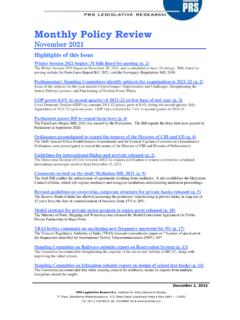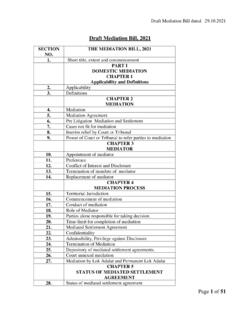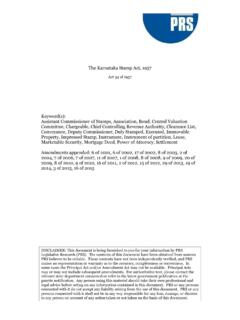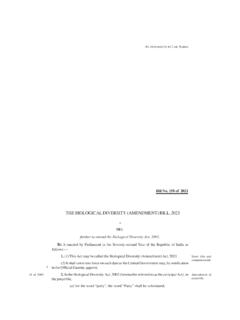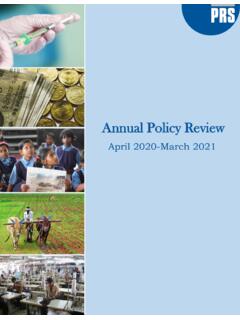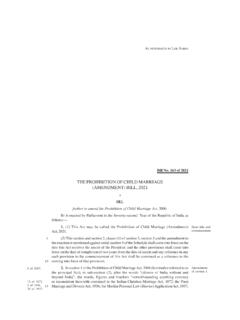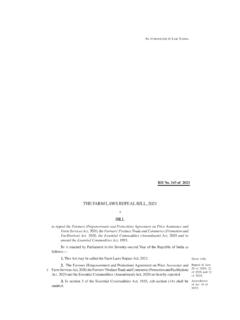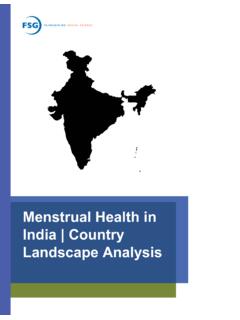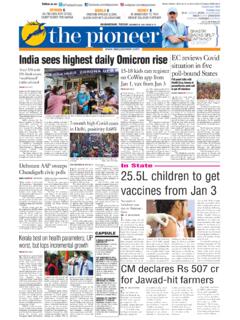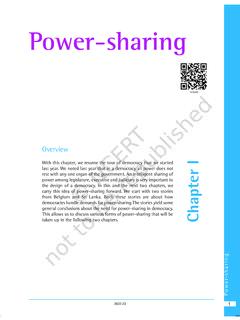Transcription of Sachar Committee Report - PRSIndia
1 Summary of Sachar Committee Report Background (b) determine the level of their socio-economic development;. On March 9, 2005 the Prime Minister issued a Notification for the constitution of a High Level (c) determine the relative share in public and private Committee to prepare a Report on the social, economic sector employment;. and educational status of the Muslim community of (d) determine the proportion of OBCs from Muslim India. community in the total OBC population in various states, The seven-member High Level Committee , chaired by (e) determine access to education and health services, Justice Rajindar Sachar , submitted its final Report to the municipal infrastructure and bank credit provided by Prime Minister on November 17, 2006.
2 The Government/ public sector entities. Government tabled the Justice Rajindar Sachar Committee Report in Parliament on November 30th. Key Findings The Sachar Committee has compiled data from a number Population. According to the 2001 Census, India's of sources. The Report frames these issues as related to Muslim population was about 138 million (about identity, security and equity. Barring some generic of the total population), and by 2006 the Muslim observations about the causes for the development population would be over 150 million.
3 The Report states, deficit' among Muslims, there is no explicit or detailed In India, populations of all major religions have discussion of the causes of such conditions. experienced large growth in the recent past, but the growth among Muslims has been higher than average.. Main Recommendations Between 1961 and 2001 the percent of Muslim The Committee made a number of recommendations to population increased from to address the status of the Muslim community in India, including: Table 1: Population Composition and Growth Rates (Percentage).
4 Set up an Equal Opportunity Commission to look All Hindu Muslim Christian Sikh Buddh Jain Other into grievances of deprived groups like minorities. 1961 100 Create a nomination procedure to increase 1971 100 participation of minorities in public bodies. 1981 100 1991 100 Establish a delimitation procedure that does not 2001 100 reserve constituencies with high minority population Increase for SCs. (1961-2001) 134 126 194 124 145 144 108 286. Annual growth Increase employment share of Muslims, particularly (exponential) where there is great deal of public dealing.
5 Work out mechanisms to link madarsas with higher secondary Muslims have a higher share in the younger age groups. school board. Table 2: Age-Sex Distribution of All Population and Recognise degrees from madarsas for eligibility in Muslim Population, India 2001 (Percentage). defence, civil and banking examinations. All religions Muslims The Committee suggested that policies should sharply Male Female Male Female focus on inclusive development and mainstreaming' of 0-9 the Community while respecting diversity. For a more 10-19 detailed summary of the Committee 's recommendations, 20-29 see Appendix 1.
6 30-39 Terms of Reference 40-49 50+ The Committee 's mandate was to: Age not stated (a) Obtain relevant information and conduct a literature The Committee estimates the proportion of Muslims to survey on the relative social, economic an educational rise to 18% to 21% by 2101 under different scenarios. status of Muslims in India at the state, regional and There has been a decline in the growth rate among all district levels; groups between 1991 and 2001, including for Muslims in most states. The states with the highest percentage of Muslims include Jammu & Kashmir (67%), Assam Higher Education.
7 According to the 2001 Census, 7% of ( ), West Bengal ( ), and Kerala ( ). the population aged 20 years and above are graduates or Figure 1: Concentration of Muslim Population hold diplomas, while only 4% among the Muslim population does. The Committee Report notes that the gap between Muslims and other Socio Religious Categories (SRCs) increases as the level of education increases, and that unemployment rates among Muslim graduates is the highest among SRCs both among the poor and the non-poor. Table 5: Children Currently Studying as a Proportion of Population by Age Groups 2004-05.
8 Other Age Hindus Muslims Minorities Gen OBC SCs/STs Though the sex ratio among Muslims at 936 girls per 6-13 ( ) ( ) ( ) ( ) ( ). 1000 boys is only marginally better than the national 14-15 ( ) ( ) ( ) ( ) ( ). average of 933, the figure for the 0-6 age group is better 16-17 ( ) ( ) ( ) ( ) ( ). at 950 (927 for all religions). 18-22 ( ) ( ) ( ) ( ) ( ). Educational Conditions. The literacy rate among 23 & up ( ) ( ) ( ) ( ) ( ). Note: Figures in parentheses show the proportion of the community in the Muslims in 2001 was , below the national average respective age-group.
9 ( ) with the gap greatest in urban areas. In many states, Muslim literacy levels were higher than those of Economy and Employment & Government SCs and STs. Employment and Programmes. Worker population ratios for Muslims are significantly lower than for all Table 3: Literacy rates (2001) other SRCs in rural areas, but only marginally lower in urban areas. The lower ratios are mainly due to much All India Rural Urban lower participation in economic activity by Muslim All Male Female All Male Female women. All 59 71 46 80 86 73.
10 Hindu 59 72 46 81 88 74. Table 6: Salaried Workers Employed in Government, Public & Large Private Sectors (2004-05) (%). SC/ST 49 61 36 68 78 58. Muslim 53 62 43 70 76 63. All Others 64 77 52 85 90 78. Govt Pub/ Pvt However, the highest increase in school enrolment rates All over the past five years have occurred among SCs/STs All Hindus (with 95% increase) followed by Muslims (65%). - SC/ST The Report also noted that despite a common belief that a - OBCs large number of Muslim children attend madarsas for - Upper Caste primary education, only 3% of Muslim children among Muslim the school going age go to madarsas.
